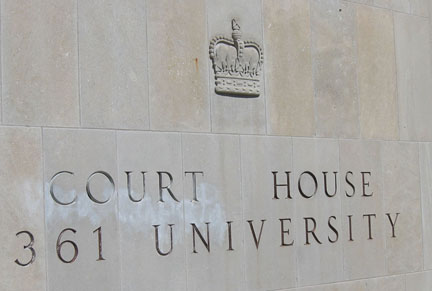One aspect of Ontario Auditor General Jim McCarter’s
annual report, released yesterday, revealed the number of Crown attorneys has more than doubled since 1993, yet the number of criminal charges is relatively the same (572,000 in 1992 compared to 576,000 in 2011).

Scott Rogers, an assistant Crown attorney and president of the Ontario Crown Attorneys’ Association, says there is good reason for this. The criminal justice system is more complex these days, he says, primarily because of the Charter of Rights and Freedoms.
“Murder trials just don’t go through our system that fast anymore,” says Rogers. “You have preliminary hearings that take weeks and weeks and weeks, followed by trials in the Superior Court that take months and months and months.”
This is partly due to the introduction of mandatory minimum sentences, which has resulted in fewer accused pleading guilty.
“What mandatory minimums do is a person who is facing charges says, ‘Well I can’t go to jail so I’m going to take my chances at trial,’” says Rogers. “So more people opt to have a trial, which means you need to have more prosecutors, you need to properly finance the legal aid system, and you need more judges.”
One of the problems, according to the auditor general’s report, is that there is no system in place to assess Crown attorneys’ workload or how cases are being handled.
“[I]t is difficult to gauge the actual impact of this on prosecutor workload, especially because the [Criminal Law Division of the Ministry of the Attorney General] makes little use of numerical and statistical information to analyze the relative workload, efficiency and effectiveness of its Crown attorneys, and relies more on informal oversight by senior staff at each of the 54 Crown attorney offices,” wrote McCarter.
Rogers says the OCAA has been asking the government for an assessment system for years.
“There’s no reason why we can’t have a system where we can assess whether Crown attorney offices and courthouses are properly staffed,” he says. “We just have to be able to have that statistic, and that’s something that our association has been saying for a long, long time because our association is not afraid of those statistics. Those statistics, we believe, will bear out that many offices are grossly understaffed.”
In the report, McCarter made reference to Manitoba’s electronic case-management system, which Alberta recently bought the rights to and will be enhancing. He criticized the division for the delay in implementing such a system in Ontario.
“A much-needed electronic case management system originally projected to cost $7.9 million and to be completed by March 2010 has been significantly delayed because of weak management, oversight and financial reporting, and insufficient resources being dedicated to the project,” said the report.
The auditor general also mentioned the Supreme Court of Canada’s 1990 ruling in
R. v. Askov, which established that a reasonable period of time for trial was generally eight to 10 months. This resulted in the dismissal of thousands of backlogged cases across the country due to unreasonable delay, according to the report.
The Ministry of the Attorney General introduced its Justice on Target project to try to reduce the number of court appearances and days to dispose of a charge. The report states that as of March 31, 2012, Justice on Target was able to reverse the long trend of increases, but still unable to meet its reduction targets.
Rogers says it’s essential to know why cases get stayed, and the only way to do that is through an assessment system.
“Cases get stayed for any number of reasons but when they get stayed for delay, then we have to know that,” he says. “If cases are getting stayed that means that the courthouse or that particular jurisdiction is understaffed.”

 Scott Rogers, an assistant Crown attorney and president of the Ontario Crown Attorneys’ Association, says there is good reason for this. The criminal justice system is more complex these days, he says, primarily because of the Charter of Rights and Freedoms.
Scott Rogers, an assistant Crown attorney and president of the Ontario Crown Attorneys’ Association, says there is good reason for this. The criminal justice system is more complex these days, he says, primarily because of the Charter of Rights and Freedoms.